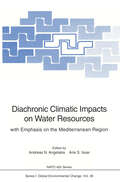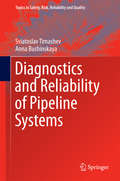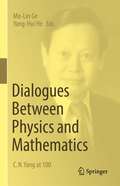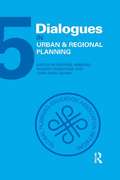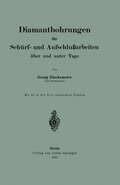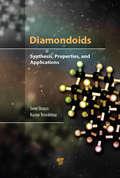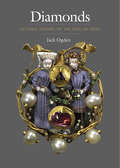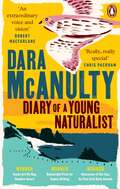- Table View
- List View
Devil in the Mountain: A Search for the Origin of the Andes
by Simon LambHow do high mountain ranges form on the face of the Earth? This question has intrigued some of the greatest philosophers and scientists, going back as far as the ancient Greeks. Devil in the Mountain is the story of one scientist, author Simon Lamb, and his quest for the key to this great geological mystery. Lamb and a small team of geologists have spent much of the last decade exploring the rugged Bolivian Andes, the second highest mountain range on Earth--a region rocked by earthquakes and violent volcanic eruptions. The author's account is both travelogue and detective story, describing how he and his colleagues have pursued a trail of clues in the mountains, hidden beneath the rocky landscape. Here, the local silver miners strive to appease the spirit they call Tio-the devil in the mountain. Traveling through Bolivia's back roads, the team has to cope with the extremes of the environment, and survive in a country on the verge of civil war. But the backdrop to all these adventures is the bigger story of the Earth and how geologists have gone about uncovering its secrets. We follow the tracks of the dinosaurs, who never saw the Andes but left their mark on the shores of a vast inland sea that covered this part of South America more than sixty-five million years ago, long before the mountains existed. And we learn how to find long lost rivers that once flowed through the landscape, how continents are twisted and torn apart, and where volcanoes come from. By the end of their journey, Lamb and his team turn up extraordinary evidence pointing not only to the fundamental instability of the Earth's surface, but also to unexpected and profound links in the workings of our planet.
Devil in the Mountain: A Search for the Origin of the Andes (PDF)
by Simon LambHow do high mountain ranges form on the face of the Earth? This question has intrigued some of the greatest philosophers and scientists, going back as far as the ancient Greeks. Devil in the Mountain is the story of one scientist, author Simon Lamb, and his quest for the key to this great geological mystery. Lamb and a small team of geologists have spent much of the last decade exploring the rugged Bolivian Andes, the second highest mountain range on Earth--a region rocked by earthquakes and violent volcanic eruptions. The author's account is both travelogue and detective story, describing how he and his colleagues have pursued a trail of clues in the mountains, hidden beneath the rocky landscape. Here, the local silver miners strive to appease the spirit they call Tio-the devil in the mountain. Traveling through Bolivia's back roads, the team has to cope with the extremes of the environment, and survive in a country on the verge of civil war. But the backdrop to all these adventures is the bigger story of the Earth and how geologists have gone about uncovering its secrets. We follow the tracks of the dinosaurs, who never saw the Andes but left their mark on the shores of a vast inland sea that covered this part of South America more than sixty-five million years ago, long before the mountains existed. And we learn how to find long lost rivers that once flowed through the landscape, how continents are twisted and torn apart, and where volcanoes come from. By the end of their journey, Lamb and his team turn up extraordinary evidence pointing not only to the fundamental instability of the Earth's surface, but also to unexpected and profound links in the workings of our planet.
Devising a Clean Energy Strategy for Asian Cities
by Hooman FarzanehThis book capitalizes on two hot topics: the Low Carbon Emission Development Strategies and climate change in Asian cities. There is resurgence in making policies to investigate more aspects of the energy-environment spectrum for the global energy market in the future. This book helps the policy makers and researchers to understand which actions should be taken to reduce the environmental impacts of economic activities in different regions in Asia. The clean energy strategy proposed in this book refers to the development and implementation of policies and strategies that simultaneously contribute to addressing climate change and solving local environmental problems, which also have other development impacts. It provides insights to a wide audience on successful ways to promote, design and implement the clean energy policies in Asian cities. To determine the global actions, it is necessary to make breakthroughs by promoting further research and to present scenarios that achieve Low Emission Development Strategies (LEDS) goals without dependence upon fossil fuels. The scenarios and case studies discussed in this book are helpful to plan for the SDGs, where various objectives have to be achieved at the same time. The UN 2030 development agenda needs innovative planning to achieve multiple goals with limited resources and generate synergy among sectors. This book will be one of the first books available on this subject.
Devonian Paleoenvironments of Ohio (SpringerBriefs in Earth Sciences)
by Rituparna BoseCarbonate depositional systems in the Paleozoic geologic time represent fewer studies in paleoecological interactions than the siliciclastic systems. To evaluate this difference, the paleontology of the Middle Devonian Dundee Formation in Ohio has been explored. This geologic formation represents an important environment in the Michigan Basin of North America. Understanding biotic relationships such as mutualism, commensalism, parasitism and predation in an ecological community is important in unraveling the mystery of the fossil record. This research has contributed a large field collection which will be useful in documenting the fossil content of this unit for future workers. Rituparna Bose used new microscopic and imaging techniques in qualitatively analyzing the biotic interactions in small invertebrate shells. More importantly, she solved complex hypotheses in newly emerging problems in the field of geology and paleontology, such as the biodiversity crisis. Her study involved exploring the Devonian geology and paleontology of a geologic formation of a new unexplored quarry in Ohio, namely the Whitehouse Quarry in Lucas County, Ohio. She identified Devonian brachiopods to the genus level based on their morphology, and diagnosed paleoecological entities on host brachiopods and further measured episkeletobiont traces on hosts to understand the effects of environment and evolution on extinct species. Such studies have implications in predicting future biodiversity, ecosystem conservation and climate change. This research will also assist future workers to compare the ecology of brachiopod hosts of the Dundee Limestone with that of other Devonian brachiopods, from both carbonate and siliciclastic settings.
DeWitt Clinton and Amos Eaton: Geology and Power in Early New York
by David I. SpanagelDavid I. Spanagel explores the origins of American geology and the culture that promoted it in nineteenth-century New York. Focusing on Amos Eaton, the educator and amateur scientist who founded the Rensselaer School, and DeWitt Clinton, the masterful politician who led the movement for the Erie Canal, Spanagel shows how a cluster of assumptions about the peculiar landscape and entrepreneurial spirit of New York came to define the Empire State. In so doing, he sheds light on a particularly innovative and fruitful period of interplay among science, politics, art, and literature in American history.
DeWitt Clinton and Amos Eaton: Geology and Power in Early New York
by David I. SpanagelDavid I. Spanagel explores the origins of American geology and the culture that promoted it in nineteenth-century New York. Focusing on Amos Eaton, the educator and amateur scientist who founded the Rensselaer School, and DeWitt Clinton, the masterful politician who led the movement for the Erie Canal, Spanagel shows how a cluster of assumptions about the peculiar landscape and entrepreneurial spirit of New York came to define the Empire State. In so doing, he sheds light on a particularly innovative and fruitful period of interplay among science, politics, art, and literature in American history.
DGT-based Measurement of Phosphorus in Sediment Microzones and Rhizospheres
by Shengrui Wang Zhihao WuThis book focuses on the development of DGT (diffusive gradients in thin films) and the related techniques for measuring and investigating the geochemical process and P transfer across the sediment/water or sediment/root interface in lakes. A series of DGT techniques such as new types of probes, test methods in sediment or the rhizosphere, DIFS (DGT induced fluxes in sediments and soils) model for kinetic P exchange, CID (computer imaging densitometry) for S(-II), and microchelex gel/LA-ICP-MS (laser ablation inductively coupled plasma mass spectrometry) have been developed. The corresponding chapters on the theory and methodology of DGT, the “internal P loading” or P transfer across sediment/root in two lakes, provide insights into the research method and conclusions, including the P release mechanism, the quantification of “internal P loading”, kinetic P exchange in DGT/sediment interface, Fe- or S(-II)-microniches at submillimeter scales in sediments for the prediction of P release, and DGT as a surrogate for the prediction of P uptake by roots. It also offers new perspectives in the fields of P analysis and P process in micro-interfaces in lakes using DGT techniques. The P remobilization from Fe-bound P, the coupled Fe-S(-II)-P geochemical reaction and algae biomass breakdown causing P release, are elucidated using DGT methods in sediment layers. DGT parameters and curves for time or distance derived from DIFS can be used to assess kinetic P release in the sediment microzone. CID and LA-ICP-MS methods deliver Fe- and S(-II) images at submillimeter scales, which can be used for the quantification of flux related to microniche peaks and the prediction of P release from Fe-microniche or Fe-S(-II)-P geochemical reactions. DGT measurements in-situ in rhizosphere or rhizonbox can give CE (effective concentration) and CDGT values for the prediction of P accumulated in plant tissues.This book provides a valuable reference resource for senior graduate students, lecturers and researchers in the fields of the geochemical process of eutrophic elements in lakes, lake eutrophication mechanism and environmental analysis.
Dhaka Megacity: Geospatial Perspectives on Urbanisation, Environment and Health (Springer Geography)
by Ashraf Dewan Robert CornerThe book Dhaka Megacity: Geospatial Perspectives on Urbanisation, Environment and Health presents the use of geospatial techniques to address a number of environmental issues, including land use change, climatic variability, urban sprawl, population density modelling, flooding, environmental health, water quality, energy resources, urban growth modelling, infectious diseases and the quality of life. Although the work is focused on the Megacity of Dhaka in Bangladesh, the techniques and methods that are used to research these issues can be utilized in any other areas where rapid population growth coupled with unplanned urbanization is leading to environmental degradation. The book is useful for people working in the area of Geospatial Science, Urban Geography, Environmental Management and International Development. Since the chapters in the book cover a range of environmental issues, this book describes useful tools for assisting informed decision making, particularly in developing countries.
Diachronic Climatic Impacts on Water Resources: with Emphasis on the Mediterranean Region (Nato ASI Subseries I: #36)
by Andreas N. Angelakis and Arie S. IssarSince the beginning of man's existence on Earth, the adequacy of available water has been as important as any other factor for man's survival and prosperity. The volume comprises comprehensive reviews on: Paleoenvironments of arid land, climate-water-man interactions, water resources in the Minoan era, ancient Greek examples of avoiding water shortages, climatic changes in the eastern Mediterranean region since 5000 B.C., climatic evolution in ancient civilizations based on fossil studies, impact of climatic changes on groundwater and Mediterranean wetlands. The book is written for civil and agricultural engineers, hydrologists, geologists, environmental scientists and researchers. It is also useful as a reference to consulting engineers, agriculturists, environmentalists and students.
Diagenese klastischer Sedimente
by Reinhard Hesse Reinhard GauppDieses Lehrbuch stellt das Gesamtgebiet der Diagenese klastischer Sedimente dar. Neben der Einführung und Abgrenzung der Diagenese umfasst das Buch entscheidende Vorgänge, die für die Bildung der wichtigsten fossilen Energieressourcen wie Erdöl, Gas, Kohle und z. T. Uran verantwortlich sind. Die Schwerpunkte der Darstellung liegen dabei auf der diagenetischen Entwicklung von Porenwässern in heutigen Offshore-Bereichen und intrakontinentalen Becken, der Diagenese kieseliger und toniger Sedimente sowie der Sandsteindiagenese.Dieses Autorenwerk hebt sich durch seine Einheitlichkeit in der Darstellung von vielen bereits bestehenden Sammelbänden ab. Es enthält neugezeichnete Schwarz-Weiß-Abbildungen sowie zahlreiche aussagekräftigen farbige Dünnschliff-Abbildungen.
Diagnosing Hemp and Cannabis Crop Diseases
by Dr Shouhua WangHemp and cannabis, both belonging to Cannabis sativa, have emerged as some of the most valuable crops because of their multiple functionalities - industrial, medicinal, and recreational uses. Like all other crops, they are at risk of diseases and pests. In certain cases, an entire hemp field can fail due to unexpected disease. As a new and highly regulated crop, research on Cannabis crop diseases is scarce, and the science of plant diagnostics is not well covered in the literature. Taking hemp/cannabis as a model crop, the book illustrates how to diagnose a disease problem and how to manage it effectively. It presents real disease cases encountered during crop production, and explains methods of diagnosis, both in the field and in the lab, in order to find out the cause(s). The book provides: ·A field and laboratory guide to diagnosing hemp and cannabis diseases and pest problems ·Ready-to-adopt skills, methods and protocols in plant diagnosis, which can be applied to other crops ·Over 300 colour photographs accompanied by a wealth of disease information, including field observations, unique symptoms, microscopic details, and molecular data. This book is essential for anyone who is interested in learning about Cannabis crop diseases, for crops grown in the field, and in indoor production facilities.
Diagnostics and Reliability of Pipeline Systems (Topics in Safety, Risk, Reliability and Quality #30)
by Sviatoslav Timashev Anna BushinskayaThe book contains solutions to fundamental problems which arise due to the logic of development of specific branches of science, which are related to pipeline safety, but mainly are subordinate to the needs of pipeline transportation. The book deploys important but not yet solved aspects of reliability and safety assurance of pipeline systems, which are vital aspects not only for the oil and gas industry and, in general, fuel and energy industries , but also to virtually all contemporary industries and technologies.The volume will be useful to specialists and experts in the field of diagnostics/ inspection, monitoring, reliability and safety of critical infrastructures. First and foremost, it will be useful to the decision making persons —operators of different types of pipelines, pipeline diagnostics/inspection vendors, and designers of in-line –inspection (ILI) tools, industrial and ecological safety specialists, as well as to researchers and graduate students.
Dialect and Language Variation
by Michael D. LinnThis anthology emphasizes dialects of American English and language variation in America. The editors present original essays by today's leading investigators, including articles by some of Europe's best dialectologists, obtained expressly for this work.Important topics featured in Dialect and Language Variation include:**Dialect theories: linguistic geography, structural and generative dialectology, and language variation.**The nature of social dialects and language variation, with attention to women's speech.**Overview of regional dialects and area studies.**The nature and study of the relationship between ethnicity and dialects, including Black, Italian, Irish, Chicano, and Jewish ethnic groups.**The application of dialect studies to education.**Of special interest to dialectologists, sociolinguists, and English language educators and specialists, this work provides original insight into**a general background and history of dialect theory**an overview of regional geography and area studies**the principles of social dialects and language variation from several perspectives**an exploration of the relationship between ethnicity and dialects o explanations of the relationship between historical and language change**a section on how dialects and language variation can contribute to effective language instruction.
The Dialectic Relation Between Physics and Mathematics in the XIXth Century (History of Mechanism and Machine Science #16)
by Evelyne Barbin and Raffaele PisanoThe aim of this book is to analyse historical problems related to the use of mathematics in physics as well as to the use of physics in mathematics and to investigate Mathematical Physics as precisely the new discipline which is concerned with this dialectical link itself. So the main question is: When and why did the tension between mathematics and physics, explicitly practised at least since Galileo, evolve into such a new scientific theory? The authors explain the various ways in which this science allowed an advanced mathematical modelling in physics on the one hand, and the invention of new mathematical ideas on the other hand. Of course this problem is related to the links between institutions, universities, schools for engineers, and industries, and so it has social implications as well. The link by which physical ideas had influenced the world of mathematics was not new in the 19th century, but it came to a kind of maturity at that time. Recently, much historical research has been done into mathematics and physics and their relation in this period. The purpose of the Symposium and this book is to gather and re-evaluate the current thinking on this subject. It brings together contributions from leading experts in the field, and gives much-needed insight in the subject of mathematical physics from a historical point of view.
Dialogues Between Physics and Mathematics: C. N. Yang at 100
by Mo-Lin Ge Yang-Hui HeThis volume celebrates the 100th birthday of Professor Chen-Ning Frank Yang (Nobel 1957), one of the giants of modern science and a living legend. Starting with reminiscences of Yang's time at the research centre for theoretical physics at Stonybrook (now named C. N. Yang Institute) by his successor Peter van Nieuwenhuizen, the book is a collection of articles by world-renowned mathematicians and theoretical physicists. This emphasizes the Dialogue Between Physics and Mathematics that has been a central theme of Professor Yang’s contributions to contemporary science. Fittingly, the contributions to this volume range from experimental physics to pure mathematics, via mathematical physics. On the physics side, the contributions are from Sir Anthony Leggett (Nobel 2003), Jian-Wei Pan (Willis E. Lamb Award 2018), Alexander Polyakov (Breakthrough Prize 2013), Gerard 't Hooft (Nobel 1999), Frank Wilczek (Nobel 2004), Qikun Xue (Fritz London Prize 2020), and Zhongxian Zhao (Bernd T. Matthias Prize 2015), covering an array of topics from superconductivity to the foundations of quantum mechanics. In mathematical physics there are contributions by Sir Roger Penrose (Nobel 2022) and Edward Witten (Fields Medal 1990) on quantum twistors and quantum field theory, respectively. On the mathematics side, the contributions by Vladimir Drinfeld (Fields Medal 1990), Louis Kauffman (Wiener Gold Medal 2014), and Yuri Manin (Cantor Medal 2002) offer novel ideas from knot theory to arithmetic geometry.Inspired by the original ideas of C. N. Yang, this unique collection of papers b masters of physics and mathematics provides, at the highest level, contemporary research directions for graduate students and experts alike.
Dialogues in Urban and Regional Planning: Volume 5
by Michael Hibbard Robert Freestone Tore Øivin SagerDialogues in Urban and Regional Planning 5 is a selection of some of the best scholarship in urban and regional planning from around the world. The internationally recognized authors of these award-winning papers take up a range of salient issues from the theory and practice of planning. The topics they address include the effects of globalization on world cities, metropolitan planning in France and Australia, and new research in pedestrian and traffic design. The breadth of the topics covered in this book will appeal to all those with an interest in urban and regional planning, providing a springboard for further debate and research. The papers focus particularly on themes of inclusion, urban transformation, metropolitan planning, and urban design. The Dialogues in Urban and Regional Planning (DURP) book series is published in association with the Global Planning Education Association Network (GPEAN) and its member national and transnational planning schools associations.
Dialogues in Urban and Regional Planning: Volume 5
by Michael Hibbard Robert Freestone Tore Øivin SagerDialogues in Urban and Regional Planning 5 is a selection of some of the best scholarship in urban and regional planning from around the world. The internationally recognized authors of these award-winning papers take up a range of salient issues from the theory and practice of planning. The topics they address include the effects of globalization on world cities, metropolitan planning in France and Australia, and new research in pedestrian and traffic design. The breadth of the topics covered in this book will appeal to all those with an interest in urban and regional planning, providing a springboard for further debate and research. The papers focus particularly on themes of inclusion, urban transformation, metropolitan planning, and urban design. The Dialogues in Urban and Regional Planning (DURP) book series is published in association with the Global Planning Education Association Network (GPEAN) and its member national and transnational planning schools associations.
Diamondoids: Synthesis, Properties, and Applications
by Sven Stauss Kazuo TerashimaOver the past few decades, carbon nanomaterials, most commonly fullerenes, carbon nanotubes, and graphene, have gained increasing interest in both science and industry, due to their advantageous properties that make them attractive for many applications in nanotechnology. Another class of the carbon nanomaterials family that has slowly been gaining (re)newed interest is diamond molecules, also called diamondoids, which consist of polycyclic carbon cages that can be superimposed on a cubic diamond lattice. Derivatives of diamondoids are used in pharmaceutics, but due to their promising properties—well-defined structures, high thermal and chemical stability, negative electron affinity, and the possibility to tune their bandgap—diamondoids could also serve as molecular building blocks in future nanodevices. This book is the first of its kind to give an exhaustive overview of the structures, properties, and current and possible future applications of diamondoids. It contains a brief historical account of diamondoids, from the discovery of the first diamondoid member, adamantane, to the isolation of higher diamondoids about a decade ago. It summarizes the different approaches to synthesizing diamondoids. In particular, current research on the conventional organic synthesis and new approaches based on microplasmas generated in high-pressure and supercritical fluids are reviewed and the advantages and disadvantages of the different methods discussed. The book will serve as a reference for advanced undergraduate- and graduate-level students in chemistry, physics, materials science, and nanotechnology and researchers in macromolecular science, nanotechnology, chemistry, biology, and medicine, especially those with an interest in nanoparticles.
Diamondoids: Synthesis, Properties, and Applications
by Sven Stauss Kazuo TerashimaOver the past few decades, carbon nanomaterials, most commonly fullerenes, carbon nanotubes, and graphene, have gained increasing interest in both science and industry, due to their advantageous properties that make them attractive for many applications in nanotechnology. Another class of the carbon nanomaterials family that has slowly been gaining (re)newed interest is diamond molecules, also called diamondoids, which consist of polycyclic carbon cages that can be superimposed on a cubic diamond lattice. Derivatives of diamondoids are used in pharmaceutics, but due to their promising properties—well-defined structures, high thermal and chemical stability, negative electron affinity, and the possibility to tune their bandgap—diamondoids could also serve as molecular building blocks in future nanodevices. This book is the first of its kind to give an exhaustive overview of the structures, properties, and current and possible future applications of diamondoids. It contains a brief historical account of diamondoids, from the discovery of the first diamondoid member, adamantane, to the isolation of higher diamondoids about a decade ago. It summarizes the different approaches to synthesizing diamondoids. In particular, current research on the conventional organic synthesis and new approaches based on microplasmas generated in high-pressure and supercritical fluids are reviewed and the advantages and disadvantages of the different methods discussed. The book will serve as a reference for advanced undergraduate- and graduate-level students in chemistry, physics, materials science, and nanotechnology and researchers in macromolecular science, nanotechnology, chemistry, biology, and medicine, especially those with an interest in nanoparticles.
Diamonds: An Early History of the King of Gems
by Jack OgdenA lavishly illustrated, in-depth early history covering two thousand years of diamond jewelry and commerce, from the Indian mines to European merchants, courts, and workshops This richly illustrated history of diamonds illuminates myriad facets of the “king of gems,” including a cast of larger-than-life characters such as Alexander the Great, the Mughal emperor Jahangir, and East India Company adventurers. It’s an in-depth study tracing the story of diamonds from their early mining and trade more than two thousand years ago to the 1700s, when Brazil displaced India as the world’s primary diamond supplier. Jack Ogden, a historian and gemologist specializing in ancient gems and jewelry, describes the early history of diamond jewelry, the development of diamond cutting, and how diamonds were assessed and valued. The book includes more than one hundred captivating images, from close-up full-color photographs of historic diamond-set jewelry (some previously unpublished), to photomicrographs of individual gems and illustrations of medieval manuscripts, as well as diagrams depicting historical methods of cutting and polishing diamonds.
Diamonds from the Arkhangelsk Province, NW Russia (Springer Mineralogy)
by Victor Garanin Konstantin Garanin Galina Kriulina George SamosorovThis book examines and summarizes data on more than 40,000 diamonds from deposits in Russia’s diamondiferous Arkhangelsk province.The geological data of diamond deposits includes the geological setting, ore body morphology and mineral composition. Investigation techniques employed include: Color Cathode Luminescence, Fourier Transform Infrared Spectroscopy, Electron Paramagnetic Resonance, Raman Spectroscopy, and Carbon Isotopy. The book provides a full description of the diamond morphology.The problems of a potential (mantle) diamond grade for deposits are considered, depending on the physical and chemical conditions involved in the genesis and growth of diamond crystals. Further, there can be a significant impact on the productivity of bodies and the properties of diamonds during post-crystallization metasomatic processes.In this book, the authors propose a diamond crystallization model for changes in diamond crystals within mantle metasomatic transformations, and identify the factors affecting the growth and dissolution of diamonds in the mantle. In addition, they describe the complex evolution of kimberlite from the mantle up to the Earth’s surface. All of these factors affect the quality and quantity of diamonds in a particular diamond deposit, providing the basis for identifying optimal technological mining processes.
Diamonds in Nature: A Guide to Rough Diamonds
by Ralf Tappert Michelle C. TappertDiamonds in Nature: A Guide to Rough Diamonds illustrates the range of crystal shapes, colours, surface textures, and mineral inclusions of rough, uncut, naturally forming diamonds. Each chapter contains photographs that show the unique physical characteristics of the diamonds, and the accompanying text describes the processes that led to their formation. This book is an invaluable reference manual for professional geoscientists—including gemmologists and exploration geologists.
The Diaries of a Bonedigger: Harold Rollin Wanless in the White River Badlands of South Dakota, 1920–1922
by Harold Rogers Wanless Emmett EvanoffThrough the original writings and photography of renowned geologist Harold Rollin Wanless, this book paints a thorough and engaging picture of the White River Badlands’ landscape, geology, biology, pioneer settlers, and how life was lived 100 years ago in a harsh, challenging, remote setting. In the summer of 1920, Harold Rollin Wanless, fresh from an undergraduate geology degree at Princeton, spent the first of three summers in the Badlands of South Dakota camping, hiking, and collecting fossil vertebrate skulls. Harold produced a fascinating and thorough diary and report, illustrated with over 100 image plates, in which he explains the geology, biology, and climate of this famous area. Wanless became deeply involved with and vividly records the life, hopes, trials and character of the new homesteading pioneers of the area, and the people and livelihoods he encountered are reflected in the diary as well. This is an engaging look at the history, environment, people and geological character of a unique portion of the American West. Combining a first-hand look at the White River Badlands and its people a century ago with the fossil history contained in its Cenozoic sediments gives a well-rounded historical presentation. This diary was found, compiled, and edited by Drs. Harold Rogers Wanless (the diarist’s son and an accomplished geologist himself) and Emmett Evanoff. In the introductory and concluding chapters of this book, they provide a broader perspective of Harold Rollin Wanless’s life and his significant achievements beyond the Badlands venture described here. In addition, this narrative - written “only” a century ago - provides a stark contrast with how we travel, communicate, conduct research and survive today, yet shows that human curiosity and kindnesses have not changed.
Diary of a Young Naturalist: Winner of the Wainwright Prize for Nature Writing 2020
by Dara McAnultyWINNER OF THE 2020 WAINWRIGHT PRIZE FOR NATURE WRITINGWINNER OF THE AN POST IRISH BOOK AWARD FOR NEWCOMER OF THE YEAR 2020WINNER OF THE BOOKS ARE MY BAG READERS AWARDS FOR NON-FICTION 2020SHORTLISTED FOR WATERSTONES BOOK OF THE YEAR 2020LONGLISTED FOR THE BAILLIE GIFFORD PRIZE 2020'Really, really special' CHRIS PACKHAM'An extraordinary voice and vision' ROBERT MACFARLANEDiary of a Young Naturalist chronicles the turning of Dara McAnulty's world, from spring to summer, autumn to winter, on his home patch, at school, in the wild and in his head. Evocative, raw and beautifully written, this startling and special book vividly explores the natural world from the perspective of an autistic teenager coping with the uprooting of home, school, and his mental health, while pursuing his life as a conservationist and environmental activist. In a work of power and hope, Dara recalls his sensory encounters in the wild - with blackbirds, whooper swans, red kites, hen harriers, frogs, dandelions, Irish hares and more - while drawing a moving portrait of a young activist dealing with change, and a family making their way in the world.'One of the most talented and passionate writers of our era' STEVE SILBERMAN






